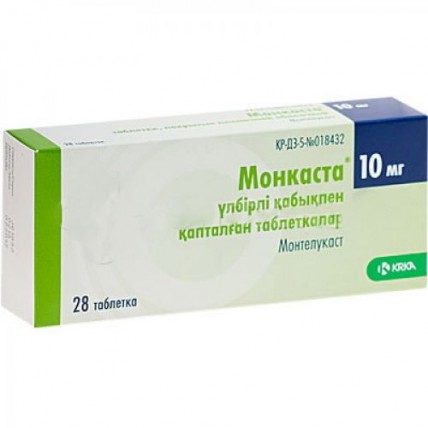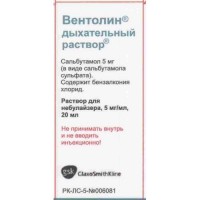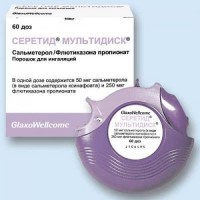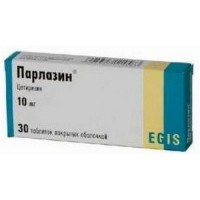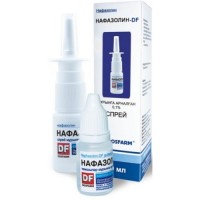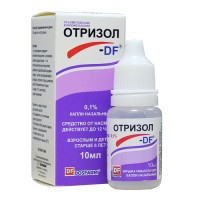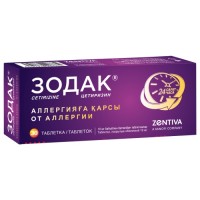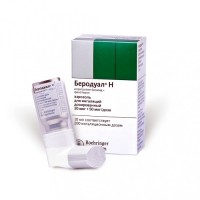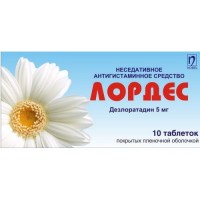Monkasta 28's 10 mg film-coated tablets
- $41.50
The instruction for medical use of MONKASTA®® medicine Trade name МОНКАСТА®® the International unlicensed name montelukast the Dosage form of the Tablet, film coated 10 mg Structure One tablet contains active agent: montelukast of sodium of 10.4 mg 10 mg are equivalent to montelukast, excipients: tsellaktoza *, cellulose microcrystalline, sodium of a kroskarmeloz, magnesium stearate structure of a film cover of Opadry Orange 03H32599: gipromeloza, titan dioxide (E171), talc, propylene glycol, ferrous oxide red (E172), ferrous oxide yellow (E172). * the Description of the Tablet of round shape, with slightly biconvex surface, film coated apricot color with a facet consists of 75% of alpha lactose of monohydrate and 25% of powder of cellulose. Pharmacotherapeutic group Other drugs for treatment of obstructive respiratory diseases for system use. Leukotriene receptors antagonists. The code of automatic telephone exchange R03DC03 the Pharmacological Pharmacokinetics Absorption Montelukast properties quickly and almost is completely soaked up at oral administration. At adults at reception on an empty stomach of tablets of coated 10 mg average peak concentration in plasma (Cmax) is reached in three hours. The bioavailability at intake is 64%. Intake of usual food does not affect bioavailability and Cmax. Tablets film coated 10 mg, are effective and safe irrespective of meal time. Distribution Montelukast more than for 99% contacts proteins of plasma. The steady volume of distribution of montelukast is about 8-11 liters. The minimum quantities hang through a blood-brain barrier. Concentration of drug in other fabrics in 24 hours after reception minimum. Biotransformation. Montelukast is intensively metabolized. When using therapeutic doses the concentration of metabolites of montelukast in plasma in an equilibrium state is not defined neither at adults, nor at children. At the research in vitro, it is proved that P450 and 3A4 cytochromes, 2C9 join in montelukast metabolism. Therapeutic concentration of montelukast in blood plasma does not inhibit P450, 3A4, 1A2, 2A6, 2C19 or 2D6 cytochromes. Removal Plasma clearance of montelukast averages 0.75 ml/sec. (45 ml/min.) at the healthy adult. 86% of drug are removed within 5 days through fecal masses, less than 0.2% - with urine. Montelukast and its metabolites are almost completely excreted through bile. The average half-life period of montelukast varies from 2.7 to 5.5 hours. The pharmacokinetics of montelukast is almost linear in the dose of 50 mg accepted orally. At single dose of a dosage of 10 mg of montelukast only the insignificant accumulation of drug in plasma (about 14%) is observed. Patients with a renal or liver failure. There is no need to select a dose. Child Pugh & gt do not have clinical data for patients with serious hepatic (9) insufficiency. A pharmacodynamics Cysteic leukotrienes (LTC4, LTD4, LTF4) are the strong inflammatory eicosanoids released from various cells including mast cells and eosinophils. It is an important pro-asthmatic mediator which contacts receptors of cysteic leukotrienes (CysLT). CysLT receptors of type-1 (CysLT1) are in airways of the person (including, in cells of smooth muscles of airways and airways of macrophages) and other pro-inflammatory cells (including eosinophils and some myeloid stem cells). CysLT correlate to a pathophysiology of asthma and allergic rhinitises. In asthma, effects of leukotrienes include a set of reactions of airways, including a bronchospasm, slime secretion, permeability of vessels and replenishment of eosinophils. In allergic rhinitises of CysLT are released from a mucous membrane of a nose under the influence of allergen as on early, and late phases of hypersensitivity allergic reactions with symptoms of allergy-chesky rhinitis. Intranasal impact on CyLTs showed increase in resistance of airways of a nose and symptoms of congestion of a nose. Монкаста® - medicine, highly active at oral administration, with anti-inflammatory properties which considerably improves indicators of asthmatic inflammation. Biochemical and pharmacological tests showed that montelukast is connected with high degree of affinity and selectivity to CyLT1 receptors (more more preferably, in comparison with others pharmacological important receptors of airways, such as prostanoida, cholinergic or beta-adrenoceptors). Монкаста® - – strong inhibitor of physiological impacts of LTC4, LTD4 and LTF4 on CyLT1 receptors without any reaction of resistance. Causes strong inhibition of receptors of tsisteinleykotriyen in airways in patients asthmatics of Monkasta®, thereby showing ability to suppress the bronchospasm caused by inhalation of LTD4. Монкаста® in a dose of 5 mg cause blockade of LTD4 strengthening a bronkhokonstriktion. Монкаста® causes a bronkhodilatation within 2 hours at oral administration. Монкаста® it is effective as at adults, and children for prevention and treatment of chronic asthma, including protection against symptoms as in day, and at night, Monkasta® is effective for treatment aspirin - sensitive asthmatic patients for the purpose of prevention of the bronchospasm connected with efforts at physical activity. Монкаста® it is effective as alone, and in a combination with other drugs used at treatment of chronic asthma. Монкаста® and inhalation corticosteroids can be used at the same time for additive effect, or for a dose decline of corticosteroids during observation of clinical stability. Монкаста® also considerably improves morning FEV1 (the volume of the forced exhalation in 1 second), and reduces use of need beta-agonists. The medical effect is reached after the first dose and remains to constants during the day at treatment for 6 months. Effects at the patients accepting at the same time corticosteroids. Монкаста® has adittivny effect on inhalation corticosteroids that allows to use the last in smaller dosages (without stopping their use) at their concomitant use, approximately for 47%. Actions on the physical activity strengthening a bronchospasm. Монкаста® in a daily dose of 10 mg, renders protective effect at the physical activity promoting a bronchospasm at adults of 15 years and is more senior. Монкаста® considerably stops duration and width of falling of FEV1 within 60 min. after physical activity, the maximum percent of falling of FEV1posle of loading. The protective effect is observed during the entire period of treatment in the absence of accustoming, after two daily dosed Effects of enhancement and excitement of attacks of asthma. Монкаста® inhibits both early, and late phases of a bronchospasm owing to antigen reaction. Montelukast considerably reduces eosinophils of peripheral blood and in saliva that leads to clinical improvement of final indicators of asthma. Seasonal allergic rhinitis the efficiency of Monkasty® at reception of a dose of 10 mg at treatment of seasonal allergic rhinitis Is proved: statistically considerable improvement of initial indicators of day symptoms and their individual components (congestion of a nose, a rhinorrhea, an itching of a nose and sneezing) and also night symptoms and their individual components (congestion of a nose at a prosypaniye in the morning, difficulties when backfilling, prosypaniye in the middle of the night), the integrated symptoms (symptoms day and night) irrespective of time of day. Монкаста® provides average decrease in eosinophils to 13% during the entire period of treatment. Use of Monkasty® in the doses exceeding 10 mg a day is not followed by increase in efficiency of drug. Indications - prevention and treatment of chronic bronchial asthma at adults and children are more senior than 15 years - stopping of day and night symptoms of seasonal allergic rhinitis at adults and children is more senior than 15 years the Route of administration and doses of the Tablet Monkasta®prinimayut once a day. For treatment of asthma of the Tablet Monkasta® it is necessary to accept in the evening. For treatment of seasonal allergic rhinitis time of reception of Monkasty® can be defined individually, at the request of the patient. For treatment by bronchial asthma and allergic rhinitis it is necessary to take one pill Monkasty® once a day in the evening. Chewable tablets of 4 mg and 5 mg need to be chewed and swallowed. Adults and children are more senior than 15 years In asthma and/or seasonal allergic rhinitis take 1 pill of film coated 10 mg a day. This age group has no need of dose adjustment. The general recommendations the Therapeutic effect of the drug Monkasta® at control of parameters of asthma is reached during the first day. The drug can be taken with - or without food. Patients should continue administration of drug of Monkasta® both during remission, and at aggravation. For elderly patients, patients with a renal failure and also patients with slight or medium-weight abnormal liver functions and also depending on a floor of special selection of a dose do not need the Monkasta® Drug treatment in interrelation with other type of treatment of asthma of Monkasta® can be additional treatment to already existing. A dose decline of the drug accompanying lecheniyabronkhodilatator. Монкаста® can be additional means to the existing accompanying treatment of the patients who are accepting bronchodilators and not having adequate effect. At achievement of clinical effect (after the first dose) the dose of bronchodilator can be reduced. Inhalation corticosteroids Therapy by the drug Monkasta® provides additional medical effect at the patients accepting inhalation corticosteroids. Thus, the dose of corticosteroids can be reduced. But it is necessary to reduce gradually, under medical control. At some patients the igalyatsionny corticosteroids can be cancelled completely, but replacement by Monkastu® should not be made sharply. Side effects Often - a headache - thirst Very seldom it is also not known (it cannot be estimated according to the available database): - a mydriasis - spasms - nausea, vomiting, dyspepsia, diarrhea - an arthralgia, myalgias, including muscular spasms - the increased bleeding, bruises - hypostases - reactions of hypersensitivity (including an acute anaphylaxis, a Quincke's edema, an itching, rash, a small tortoiseshell, and it is very rare - hepatic eosinophilic infiltration) - a nightmare and hallucinations, irritability, drowsiness, insomnia, excitement, including agressive behavior, concern. If there are heavy undesirable effects, treatment has to be stopped. Contraindications - the hypersensitivity to montelukast or any other component of drug Medicinal interactions of Monkasta® can be accepted along with other drugs which are usually used for prevention and treatment of chronic asthma and allergic rhinitis. Монкаста® has no clinically significant impact on pharmacokinetics of the following drugs: theophylline, Prednisonum, Prednisolonum, oral contraceptives (ethinylestradiol, oestradiol / norethindrone 351), terfenadina, digoxin and warfarin. At simultaneous use with phenobarbital the area under a curve curve "concentration – time" (AUC) for montelukast decreases approximately by 40%. The special instructions Efficiency of the Drug Monkasta® for treatment of exacerbations of asthma (at attacks) it was not established. Thus, it is not necessary to rely on the tablets Monkasta® for treatment of bad attacks of asthma. Patients need to recommend to have the corresponding available drugs for removal of attacks. At the same time the dose of the accompanying inhalation corticosteroids can be reduced gradually, under observation of the doctor, but administration of drug of Monkasta® should not stop sharply. Reduction of the general dose of corticosteroids at the patients accepting antagonists of receptors of leukotrienes it was applied in rare instances at approach of one or more of the following actions: an eosinophilia, vaskulitny rash, deteriorations in pulmonary symptoms, cardiovascular complications, and/or neuropathies, sometimes at Churg-Strauss syndrome, a system eosinophilic vasculitis. Though to relationship of cause and effect with receptors of leukotrienes it was not established, the care and the corresponding control of clinical indicators are recommended at reduction of system corticosteroids at the patients accepting montelukast.Listen Special information on some ingredients. Монкаста® contains lactose, patients with congenital intolerance of a galactose, deficit of Lapp of lactase or a sprue of a glucose/galactose cannot use this drug. Pregnancy and the period of a lactation the Drug Monkasta® was not studied at pregnant women. It can be accepted only in urgent cases. Whether montelukast with breast milk is emitted it is unknown. It is necessary to apply with care at the feeding women. There Is no feature of influence of medicine on ability to run the vehicle or potentially dangerous mechanisms any proofs that Monkasta® affects ability to run vehicles and units. Overdose Symptoms: thirst, drowsiness, mydriasis, hyperkinesias and abdominal pain. Treatment: Symptomatic. It is unknown whether it is dialyzed montelukst by peritoneal dialysis or a hemodialysis. The form of release and packing of the Tablet place film coated 10 mg On 7 or 14 tablets in blister strip packaging from a film of OPA/Al/PVC and aluminum foil. On 2 (the blister on 14 tablets) or 4 (the blister on 7 tablets) blister strip packagings together with the instruction for use in the state and Russian languages Storage conditions place in a pack from cardboard to Store at a temperature not above 30 °C. To store out of children's reach! Period of storage 2 years. Not to apply until the storage expiration Prescription status According to the prescription the Producer of KRK, of. The place is new, Slovenia Shmaryeshka 6, 8501 the place, Slovenia the Address of the organization accepting in the territory of the Republic of Kazakhstan claims from consumers on quality of products (goods) Representation "KRK, of Is new. The place" in RKRK, 050059, Almaty, Al-Farabi Ave., 5/1, section 3 A is new, the 4th etazhtet.: +7 (727) 311 08 09 fax: +7 (727) 311 08 12www.krka.si
to Develop
to Develop
